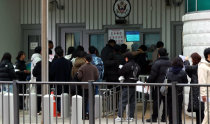Documents Show U.S. Deployed Nuclear Weapons in Gangwon Province in 1987
Documents Show U.S. Deployed Nuclear Weapons in Gangwon Province in 1987
Posted September. 24, 2005 07:12,
It has been confirmed that strategic nuclear weapons were deployed at Camp Page in Chuncheon, Gangwon Province in 1987, and that the U.S. Air Force practiced nuclear bomb drops, simulating a preemptive nuclear attack on North Korea, in 1998. This was revealed on September 23 by Uri Party Representative Choi Sung who obtained secret documents which the Nautilus Institute obtained by requesting the U.S. government to release information according to the Freedom of Information Act.
There Were Nuclear Weapons-
It is nothing new that nuclear weapons have been deployed in Korea, since strategic nuclear weapons have existed on the Korean peninsula since the 1950s, and were completely withdrawn by July 1992. However, it is the first time ever that where the weapons were located has been specifically confirmed.
There have only been estimates as to their deployment locations, with most of the speculation centering on the front line and the Gunsan area in Jeonbuk Province.
The data revealed by Rep. Choi includes some 40-pages of documents that a lieutenant colonel who headed the WSDK, a U.S. Force weapons support unit, signed on September 22, 1987, which specifies detailed strategy planning for firing and launching of nuclear weapons in Camp Page. The document clearly states the WSDK as a unit entirely responsible for the use and transportation of nuclear weapons against North Korea. Also, it says that a preemptive nuclear attack will utilize airplanes, vehicles and 155-milimeter trench mortars or new eight-inch trench mortars.
It also includes explanations by a nuclear weapons support team under the WSDK with detailed drawings about safety measures for all nuclear materials and nuclear equipment delivery skills.
Preemptive Nuclear Attack Plans-
Chois data also shows that the U.S. prepared for a preemptive nuclear attack on North Korea in 1998 after the 1994 Geneva Accords.
According to The History of the Fourth Combat Unit of U.S. Air Force: From January to June 1998, A F15E squadron from Seymour Johnson Air Force Base in North Carolina carried the BDU-38, a real-size model of the nuclear bomb B61 and dropped it on the bomb training ground of Avon Park in Florida, as part of a training exercise.
The document includes testimony by the then head of the unit, saying, That was training for a war in Korea, adding, The run went perfectly, from strategy preparations to the actual dropping of a nuclear bomb.
It might be a simple coincidence, but North Korea test-fired its Daepodong missile in August 1998, right after the nuclear bombing exercise by the U.S. Moreover, tensions on the Korean peninsula reached their peak in 1999, the following year, over speculation of an underground nuclear facility in Geumchang-ri, North Korea.
taewon_ha@donga.com






![노동신문 개방? 노동신문 서버는 개방을 견뎌낼까?[주성하의 ‘北토크’]](https://dimg.donga.com/c/138/175/90/1/wps/NEWS/IMAGE/2025/12/26/133032325.1.jpg)
